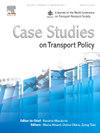Impacts of vehicle electrification on large-scale transportation and charging infrastructure: A dynamic network modeling approach
IF 2.4
Q3 TRANSPORTATION
引用次数: 0
Abstract
The rise in penetration of electric vehicles (EV) presents new challenges for infrastructure management due to the intertwining of the transportation system with the electric power system through charging infrastructure. The integration of EVs into the transportation network requires a dynamic transportation network modeling approach that considers the impacts of EV charging. Existing studies often suffer from drawbacks such as static traffic models, limited network size, and unrealistic assumptions about traffic demand and EV behavior. The study proposes a holistic framework that incorporates essential components related to EVs such as charging stations, EV charging routing, charging behavior, and energy consumption, into a dynamic traffic model for large-scale networks. The framework is applied to a large-scale transportation network in the Central Ohio region. The high granularity dynamic traffic model is calibrated with real-world traffic data and vehicle registration data, resulting in more accurate estimations of traffic flow and energy consumption. Based on the calibrated model, different scenarios are analyzed and the results reveal spatiotemporal variations in the utilization of the charging station and the patterns of neighborhood electricity consumption. Furthermore, the study analyzes the impacts of the EV penetration ratio, the roadside charging ratio, the coverage ratio of the fast charging station on the energy consumption across the network, the emission of greenhouse gases, and the waiting times at the charging stations. The proposed flexible framework provides a foundation for future studies to refine submodels and explore the interdependency between traffic and electric power systems more comprehensively.
汽车电气化对大规模交通和充电基础设施的影响:一种动态网络建模方法
电动汽车(EV)的普及给基础设施管理带来了新的挑战,因为交通系统与电力系统通过充电基础设施相互交织。电动汽车与交通网络的整合需要一种考虑电动汽车充电影响的动态交通网络建模方法。现有的研究往往存在诸如静态交通模型、有限的网络规模以及对交通需求和电动汽车行为的不切实际的假设等缺陷。该研究提出了一个整体框架,将充电站、电动汽车充电路径、充电行为和能源消耗等与电动汽车相关的基本组件整合到大规模网络的动态交通模型中。该框架应用于俄亥俄州中部地区的大型交通网络。高粒度动态交通模型采用真实交通数据和车辆登记数据进行校准,从而更准确地估计交通流量和能源消耗。在此基础上,对不同场景下的充电站利用情况进行了分析,分析结果揭示了充电站利用的时空变化特征和社区用电模式。此外,研究还分析了电动汽车普及率、路边充电率、快速充电站覆盖率对整个网络能耗、温室气体排放和充电站等待时间的影响。所提出的灵活框架为进一步细化子模型,更全面地探索交通与电力系统之间的相互依赖关系奠定了基础。
本文章由计算机程序翻译,如有差异,请以英文原文为准。
求助全文
约1分钟内获得全文
求助全文

 求助内容:
求助内容: 应助结果提醒方式:
应助结果提醒方式:


